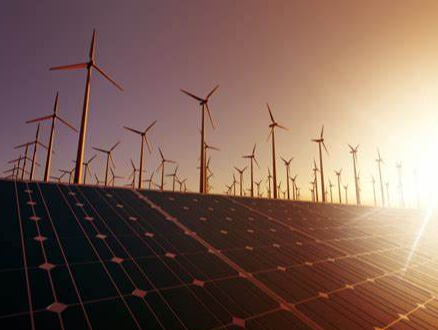Strengthening the use of renewable energy is conducive to the security of the energy system
For the eastern provinces to improve the self-sufficiency rate of non-fossil energy, Du Xiangwan expressed optimistic, he said, first of all, the eastern provinces are the leading areas of energy conservation and efficiency, is the priority area of nuclear energy development, is the advantage area of Marine energy development, is the receiving area of LNG imports, plus distributed photovoltaic, geothermal, biomass energy, including solid waste resource utilization, industrial waste heat and so on. Eastern China is rich in energy sources and abundant in resources. Through experiments and calculations, the cost of self-generated electricity in the east has been lower than the cost of west-east power transmission. Du Xiangwan said that the central and eastern regions should not only be consumers of energy, but also become producers of energy, and the transformation of energy production and consumption mode will make a large number of energy producers and marketers appear in China.
In addition, it is also necessary to use a lot of complementary energy, the existing coal power in the central and eastern regions to do a clean and efficient transformation, the use of carbon dioxide capture and storage (CCUS) to carry out flexible transformation of coal power, so that it supports renewable energy peak adjustment, and the policy should also support coal and new energy collaborative transformation, which is conducive to social progress. It is also of great significance to ensure China's energy supply and demand security, environmental and climate security.

The energy transition is about addition
Instead of subtraction
"According to the amount of annual exploitation, China's coal storage and production ratio is 40 years, oil storage and production ratio is 18 years, natural gas storage and production ratio is 30 years, and non-fossil energy including water, geothermal, biomass, tidal, nuclear energy and other technologies can be developed resources are very rich, (to) steadily and gradually from coal to renewable energy based, which is a long-term energy security policy," It is a necessary path to carbon neutrality."
Du Xiangwan pointed out that at present and in the future, fossil energy is still very important, during this period of fossil energy and non-fossil energy to coordinate and complement each other, first stand and then break, build a resilient energy system, so as to ensure the current and long-term energy security. "Don't tear down the old house until the new one is built."
"We often say that 'broken' is the gradual withdrawal of fossil energy, and I suggest changing this withdrawal to a decline." The decline is certain, but I don't feel compelled to quit." Du Xiangwan suggested that by 2060, a little fossil energy can still be retained, and some industrial links will have a little carbon dioxide emissions, and China's carbon reduction capacity can remain carbon neutral.
"The energy transition is about adding, not subtracting. It is a long-term and arduous task, but the direction is clear. It is a national goal and a global event." Du also said that even if carbon neutrality is achieved by 2060, it is only an important milestone, not the end. Human society still needs to develop, and the future society must rely on the support of future energy sources. From the perspective of future energy, the significance and historical status of the two-carbon target can be better understood.
- EMERSON
- Honeywell
- CTI
- Rolls-Royce
- General Electric
- Woodward
- Yaskawa
- xYCOM
- Motorola
- Siemens
- Rockwell
- ABB
- B&R
- HIMA
- Construction site
- electricity
- Automobile market
- PLC
- DCS
- Motor drivers
- VSD
- Implications
- cement
- CO2
- CEM
- methane
- Artificial intelligence
- Titanic
- Solar energy
- Hydrogen fuel cell
- Hydrogen and fuel cells
- Hydrogen and oxygen fuel cells
- tyre
- Chemical fiber
- dynamo
- corpuscle
- Pulp and paper
- printing
- fossil
- FANUC
- Food and beverage
- Life science
- Sewage treatment
- Personal care
- electricity
- boats
- infrastructure
- Automobile industry
- metallurgy
- Nuclear power generation
- Geothermal power generation
- Water and wastewater
- Infrastructure construction
- Mine hazard
- steel
- papermaking
- Natural gas industry
- Infrastructure construction
- Power and energy
- Rubber and plastic
- Renewable energy
- pharmacy
- mining
- Plastic industry
- Schneider
- Kongsberg
- NI
- Wind energy
- International petroleum
- International new energy network
- gas
- WATLOW
- ProSoft
- SEW
- wind
- ADVANCED
- Reliance
- YOKOGAWA
- TRICONEX
- FOXBORO
- METSO
- MAN
- Advantest
- ADVANCED
- ALSTOM
- Control Wave
- AB
- AMAT
- STUDER
- KONGSBERG
- MOTOROLA
- DANAHER MOTION
- Bently
- Galil
- EATON
- MOLEX
- Triconex
- DEIF
- B&W
- ZYGO
- Aerotech
- DANFOSS
- KOLLMORGEN
- Beijer
- Endress+Hauser
- MOOG
- KB
- Moxa
- Rexroth
- YAMAHA
- Johnson
- Westinghouse
- WAGO
- TOSHIBA
- TEKTRONIX


Email:wang@kongjiangauto.com



































































































































